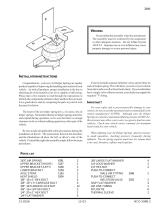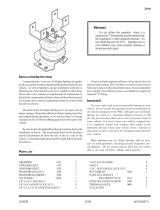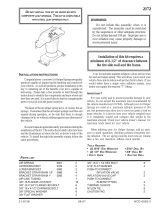
2173 / 2231
INSTALLATION INSTRUCTIONS
Congratulations - your new Ride-Rite Air Helper
Springs are quality products capable of improving the
handling and comfort of your vehicle. As with all
products, proper installation is the key to obtaining all of
the benefits your kit is capable of delivering. Please take
a few minutes to read through the instructions to identify
the components and learn where and how they are used.
It is a good idea to start by comparing the parts in your kit
with the parts list below.
The heart of the Ride-Rite kit is, of course, the air
helper springs. Remember that the air helper springs
must flex and expand during operation, so be sure that
there is enough clearance to do so without rubbing
against any other part of the vehicle.
Be sure to take all applicable safety precautions
during the installation of the kit. The instructions listed
in this brochure and the illustrations all show the left, or
driver’s side of the vehicle. To install the right side
assembly simply follow the same procedures.
Your kit includes separate inflation valves and air
lines for each air helper spring. This will allow you to
level your vehicle from side to side as well as from front
to back. If you would rather have a single valve inflation
system, your dealer can supply the required "T" fitting.
IMPORTANT!
For your safety and to prevent possible damage to
your vehicle, do not exceed the maximum load recom-
mended by the vehicle manufacturer (GVWR). Al-
though your Ride-Rite Air Helper Springs are rated at
a maximum inflation pressure of 100 P.S.I., this
pressure may allow you to carry too great a load on
some vehicles. Check your vehicle owner’s manual for
maximum loads listed for your vehicle.
When inflating your Ride-Rite Air Helper Springs,
add air pressure in small quantities, checking pressure
frequently during inflation. The air spring requires
much less air volume than a tire and, therefore, inflates
much quicker.
WARNING:
Do not inflate this assembly when it is
unrestricted. The assembly must be re-
stricted by the suspension or other adequate
structure. Do not inflate beyond 100 P.S.I.
Improper use or over inflation may cause
property damage or severe personal injury.
21-8154 07-05 NCD-5985-1
268C AIR SPRING 6762 2
LEFT UPPER BRACKET 5478 1
RIGHT UPPER BRACKET 5221 1
LOWER BRACKET 5472 2
BRACKET STRAP 1163 2
HEAT SHIELD 1004 1
AIR LINE TUBING 1
3/8"-16 FLANGE LOCK NUT 10
3/8"-16 X 3/4" HEX BOLT 2
3/8"-16 x 3" CARRIAGE BOLTS 4
3/8" SPECIAL WASHER 2
3/8"-16 X 1 1/2 CARRIAGE BOLTS 2
5/16" FLAT WASHER 4
PUSH TO CONNECT
INFLATION VALVE 2
PUSH TO CONNECT
STRAIGHT FITTING 2
THERMAL SLEEVE 2
NYLON TIE 6
SLEEVE 5224 2
PARTS LIST
L

RR 2173
KIT TO FRAME ASSEMBLY
KIT ASSEMBLY
FIGURE "A"
FRAME RAIL
FRONT
WHEEL
AXLE
BRACKET STRAP
3/8" - 16 FLANGED
LOCK NUTS
LEAF
STACK
L
3/8" -16 x 3"
CARRIAGE BOLT
SLEEVE
SPECIAL FLAT
WASHER
3/8" - 16 FLANGED
LOCK NUT
BRAKE LINE
NOTE: Both illustrations are of the left,
or drivers side, of the vehicle. Reverse any
orientations when assembling and installing
the right, or passenger, side of the vehicle.
JOUNCE
BUMPER
BRACKET
TA B
UPPER BRACKET
AIR FITTING
3/8" - 16
FLANGED LOCK NUTS
3/8" - 16 X 3/4"
FLANGED HEX BOLT
LOWER BRACKET
AIR SPRING
3/8" -16 x 1-1/2"
CARRIAGE BOLT
L
F
R
O
N
T
W
H
E
E
L
FRONT
TAB
SLEEVE
JOUNCE BUMPER
BRACKET
LOWER
BRACKET
BRACKET
STRAP
LOCK WASHERS
AIR LINE

JOUNCE BUMPER
TO BE REMOVED
AIR HOSE
INFLATION
VALVES
BUMPER
AIR
SPRINGS
STEP 1 - PREPARE THE VEHICLE
Make sure that the vehicle is on a solid level surface. Take necessary
safety precautions such as using wheel chocks when working under your
vehicle. This vehicle does not have to be jacked up to install the kit.
Remove the positive battery cable. Remove the rubber jounce bumper
under the frame rail, see Figure "B".
STEP 2 - PREASSEMBLE THE RIDE-RITE KIT
Select one air helper spring from your kit and install the air fitting
as shown in Figure "A". Tighten the air fitting securely to engage the
orange thread sealant. Insert the 1-1/2" carriage bolt into the square
hole on the left upper bracket marked "L". Align the studs on the air
spring with the holes on the upper bracket making sure the air fitting
aligns with the circular cut out, see Figure "A". Use the 3/8"-16 flanged
lock nuts to secure the upper bracket to the air spring. Position the lower
bracket as shown in Figure "A". Fasten the lower bracket to the air helper
spring using a 3/8"-16 x 3/4" flanged hex bolt (finger tight).
STEP 3 - ATTACHMENT TO THE FRAME
Place the round sleeve over the 1-1/2" carriage bolt installed earlier (see
Figure "A"). Position the assembly on the axle under the frame rail in the
location shown in Figure "A". The tab on the upper bracket will fit into
the jounce bumper bracket opening. Note that the carriage bolt will also fit
into the existing slot on the jounce bumper bracket as shown in Figure "A".
Using the 3/8" special flat washer and 3/8"-16 flanged hex nut attach the
upper bracket to the jounce bumper bracket, see Figure "A". Hint: Use a
boxed ratchet style wrench to tighten the upper bracket to the jounce
bumper bracket.
STEP 4 - LOWER BRACKET ATTACHMENT
Positioning of the lower bracket is determined by the air spring.
Visually align the air spring so that it is as vertical as possible. Once the
air spring is correctly aligned install the 3/8"-16 x 3" carriage bolts in the
square holes of the lower bracket as shown in Figure "A". The lower bracket
is then secured by two bracket straps which are placed under the axle and
fastened with 3/8"-16 flanged lock nuts, see Figure "A". After the lower
bracket is fastened to the axle tighten the air spring to the lower bracket
making sure the air spring remains in a vertical position.
STEP 5 - INSTALLATION TO THE PASSENGER'S SIDE ASSEMBLY
Reverse any orientations when assembling and installing the
right, or passenger, side of the vehicle. Use the upper bracket stamped
"R", follow steps 2-4 for assembly and installation. Note: The use of
a heat shield is required on the passenger's side of the vehicle refer
to Figure "C". The heat shield will mount between the upper bracket and
the air helper spring. Angle the heat shield so it is placed halfway between
the air helper spring and the closest point on the exhaust. Be sure that the
heat shield will not contact any other component as the suspension
compresses. (i.e. brake lines, shock absorbers, lower bracket assembly)
STEP 6 - INSTALL THE AIR LINE AND THE INFLATION VALVE
Uncoil the air line tubing and cut it into two equal lengths. DO
NOT FOLD OR KINK THE TUBING. Try to make the cut as square as
possible. Insert one end of the tubing into the straight fitting installed
in the top of the air helper spring. Push the tubing into the fitting as
far as possible refer to Figure "A".
Select a location on the vehicle for the air inflation valves. The
location can be on the bumper or the body of the vehicle, as long as
it is in a protected location so the valve will not be damaged, but maintain
accessibility for the air chuck, see Figure "D".
Figure "B"
AIR LINE
PUSH-TO-CONNECT
INFLATION VALVE
FLAT WASHER
HEX NUT
VALVE CAP
BODY OF
VEHICLE
Figure "E"
Figure "D"
HEAT SHIELD
Figure "C"

www.firestoneindustrial.com
Drill a 5/16" hole and install the air inflation valve using two 5/16" flat washers per valve as supports, see Figure "E". Run
the tubing from the air helper spring to the inflation valve, routing it to avoid direct heat from the engine, exhaust pipe, and
away from sharp edges. Thermal sleeves have been provided for these conditions. If a thermal sleeve is required simply slide
the sleeve over the air line tubing to the location requiring protection. The air line tubing should not be bent or curved sharply
as it may buckle. Secure the tubing in place with the nylon ties provided. Push the end of the air line tubing into the inflation
valve as illustrated in Figure "E".
STEP 7 - CHECK THE AIR SYSTEM
Once the inflation valves are installed inflate the air helper springs to 70 P.S.I. and check the fittings for air leaks with
an applied solution of soap and water. If a leak is detected at a tubing connection then check to make sure that the tube
is cut as square as possible and that it is pushed completely into the fitting. The tubing can easily be removed from the
fittings by pushing the collar towards the body of the fitting and then pulling out the tube. If a leak is detected where
the brass fitting screws into the spring, remove the tubing (see trouble shooting section of the operating instruction
manual for removal procedure),then screw the brass fitting into the air spring one additional turn or until the leak stops.
Reinstall the tubing and reinflate the air springs and check for leaks as noted above. Further information on trouble-
shooting can be found in the General Operation Instruction book included with this kit.
This now completes the installation. Re-attach the postive battery cable and remove the wheel chocks from the front
wheels. Before proceeding, check once again to be sure you have proper clearance around the air springs. With a load
on your vehicle and the air helper springs inflated, you must have at least 1/2" clearance around the air springs. As a
general rule, the Ride-Rite Air Helper Springs will support approximately 32 lbs. of load for each P.S.I. of inflation
pressure (per pair). For example, 50 P.S.I. of inflation pressure will support a load of 1600 lbs. per pair of air helper
springs. FOR BEST RIDE use only enough air pressure in the air helper springs to level the vehicle when viewed from
the side (front to rear). This amount will vary depending on the load, location of load, condition of existing suspension
and personal preference.
NOTE:
Too much air pressure in the air helper springs will result in a firmer ride, while too little air pressure will allow the air
helper spring to bottom out over rough conditions. Too little air pressure will also not provide the improvement in handling
that is possible. TO PREVENT POSSIBLE DAMAGE MAINTAIN A MINIMUM OF 20 P.S.I. IN THE RIDE-RITE AIR
HELPER SPRINGS AT ALL TIMES.
Enclosed with this kit are Ride-Rite Operating Instructions. Please read them for proper and safe operation.
NOTE:
Once the air helper springs are installed, it is recommended that the vehicle not be lifted by the frame, as over-
extension may occur, resulting in damage to the air helper springs. However, should it become necessary to raise the
vehicle by the frame, deflate both air helper springs completely.
-
 1
1
-
 2
2
-
 3
3
-
 4
4
Firestone 2231 User manual
- Type
- User manual
- This manual is also suitable for
Ask a question and I''ll find the answer in the document
Finding information in a document is now easier with AI
Related papers
Other documents
-
 Network Computing Devices NCD-5988-2 User manual
Network Computing Devices NCD-5988-2 User manual
-
 Network Computing Devices 2190 User manual
Network Computing Devices 2190 User manual
-
 Network Computing Devices 2172 User manual
Network Computing Devices 2172 User manual
-
Air Lift 59111 Installation guide
-
Air Lift 57245 Installation guide
-
Air Lift 57595 Installation guide
-
Air Lift 94413 Installation guide
-
Air Lift 89413 Installation guide
-
Air Lift 94412 Installation guide
-
Air Lift 89412 Installation guide











